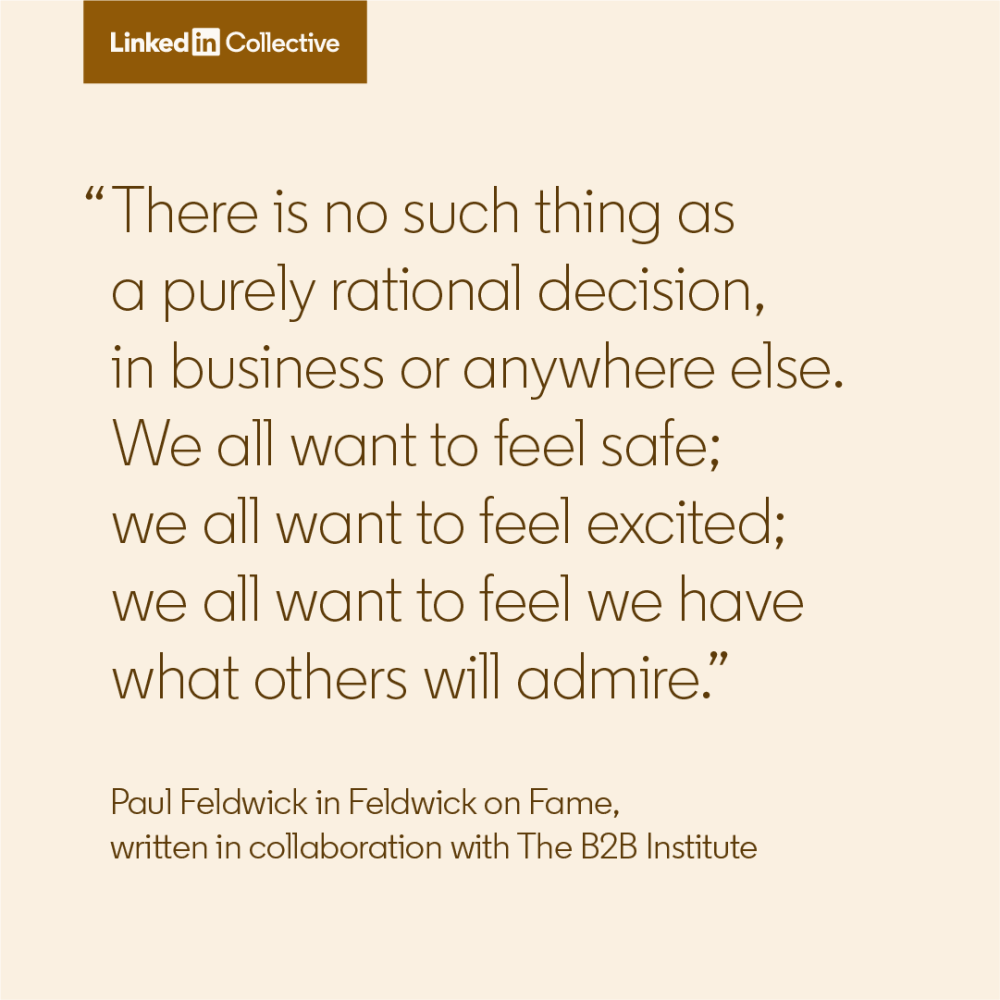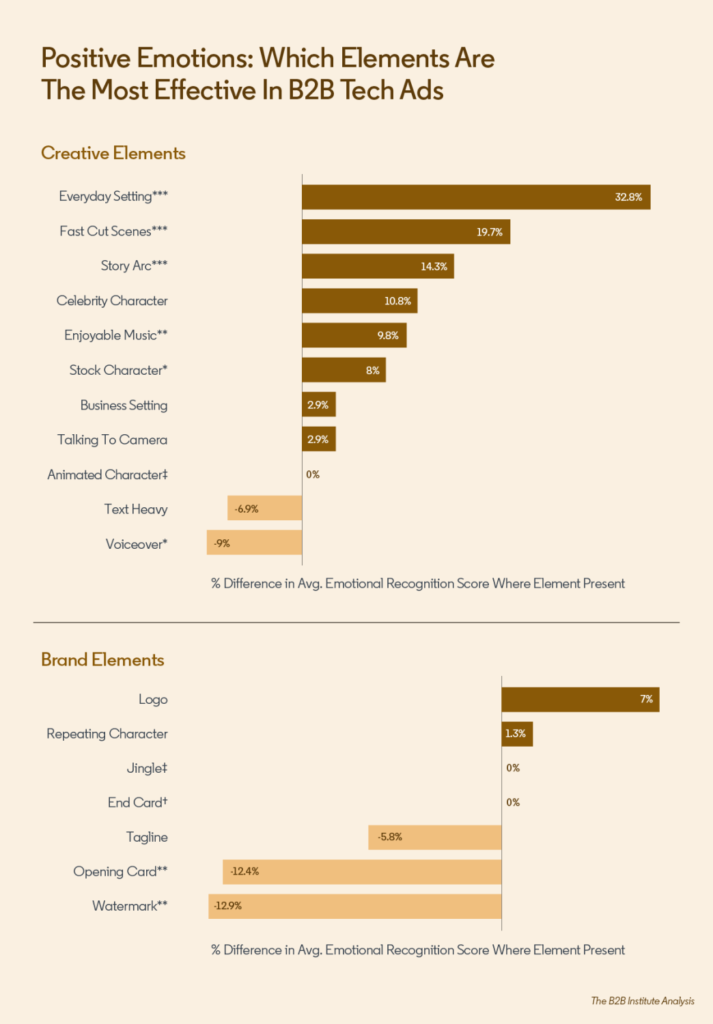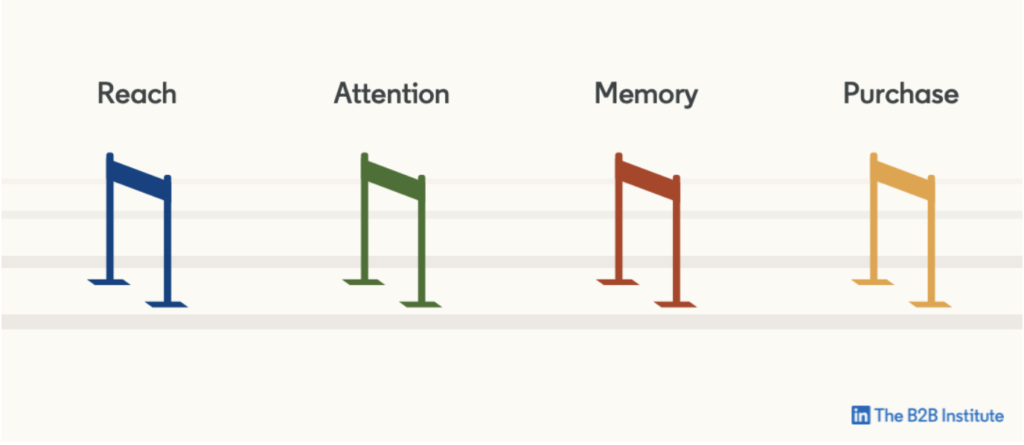The Scientific Case For Investing in Creativity in Your B2B Marketing
Editor’s note: This LinkedIn Collective post was written by Ty Heath, Director of Market Engagement at The B2B Institute.
What do a loud duck, a smooth-talking gecko, and a sunglasses-wearing emu have in common? For some reason, the answer to this question is: insurance. And odds are pretty good you can name the brands associated with each of these characters.
The brand campaigns that brought us this cast of characters managed to bring noteworthy creativity to the less-than-exciting intangible service of insurance. These characters are powerful distinctive brand assets: they are instantly recognizable and attributable to their respective brands, and they link these brands to the insurance category in the minds of consumers everywhere.
Branding, when done right, is one of the best long-term marketing investments an organization can make. And we have the science to back that up.
At The B2B Institute, we’ve been teaming up with Les Binet, Peter Field, and the experts at System1 and The Ehrenberg-Bass Institute to deliver science-backed creative insights that make the case for increasing investment in creative marketing.
What’s Tripping Up B2B Marketing

“There is no such thing as a purely rational decision, in business or anywhere else. We all want to feel safe; we all want to feel excited; we all want to feel we have what others will admire.” – Paul Feldwick in Feldwick on Fame, written in collaboration with The B2B Institute
B2B marketing has fallen into a product delusion, touting facts and figures to try to persuade buyers. The desire to demonstrate clear revenue results can lead to an overemphasis on campaigns and tactics designed to produce sales in the short-term.
This numbers-chasing game isn’t entirely the fault of marketing departments – the push for metrics comes from the top down. In 2021, we saw the largest decrease in marketing investment since 2014, though expectations are that digital ad spend will see increases over 2022.
With fluctuations in marketing budgets, is this really the time to invest in your brand and creativity?
The answer is: yes.
Cutting your spend may free up short-term cash flows, but it will also slow your future cash flows. And as any good CFO can tell you, businesses are valued based on future cash flows. It is more difficult than ever for B2B companies to succeed in the attention game, but it is also far more important. If your ads aren’t reaching out-market buyers, grabbing their attention, and building memory structures, it is challenging to influence future purchases.
The 95-5 Rule: B2B marketers need to play the long game
Our work with Professor John Dawes of the Ehrenberg-Bass Institute finds that 95% of category buyers are out-market at any given time. We call this the 95-5 Rule, and it means that most of your growth potential lies in reaching people who won’t buy from you today, but who will buy from you in the future. Of course, it’s important to capture the 5% of buyers who are in-market today with lead generation efforts. But too many B2B businesses today exclusively focus on this cohort – which places a ceiling on their growth potential.

The brand that gets remembered is the brand that gets bought. And your brand can’t be remembered in the future without laying the groundwork for those memory structures in the present.
But today’s shortcoming is tomorrow’s competitive advantage. Strong creative is the key to memory generation. System1 research in our B2B Institute report Cashing In On Creativity shows that while only 0.5% of ads evaluated scored 4-5 out of 5 stars, those ads with powerful creative offered a 10-20x sales multiplier and 10x or more share growth. That’s an enormous sales multiplier by any standard, and is arguably the largest within marketing’s control today.
Cashing In On Creativity: How to build memory and drive cash flows
- Grab attention: use emotion, storytelling, and soundtrack. Hyper-rational ads don’t grab attention, and they won’t resonate with out-market buyers at all. Use emotion, storytelling, and soundtrack to grab attention in a way that will resonate with all category buyers – whether they are out-market or in-market – and make the most of that earned attention by conveying a message that will link your brand to a specific buying situation. See some specific examples of creative and branding elements that help grab attention and evoke positive emotions from our “Anatomy Of A Great Ad: Tech Edition” research below:

2. Link your brand to a key buying situation: The brand that gets remembered is the brand that gets bought, and the brand that gets remembered when a buyer enters the market is largely influenced by the situation the buyer is in. Memory generation and recall are both inherently situational, so it’s critical that you build situation into your advertising message. Category entry points – a term you can learn more about in our latest research, “Category Entry Points In A B2B World” – reveal the buying situations that matter most to your brand. Invest in ads that directly message around these key buying situations to link your brand to them. And invest in distinctive brand assets to make sure this link occurs. Characters are one of the most ownable types of distinctive brand assets, and they are also one of the most memorable. See some specific examples of creative and branding elements that help boost brand recognition from our “Anatomy Of A Great Ad: Tech Edition” research below:

Advertising outcomes work in a series of sequential hurdles: you must first reach people to grab their attention, you must first grab their attention to build a memory, and you must first build a memory to influence a purchase.

This final hurdle proves that memory generation drives sales performance – that brand marketing is performance marketing. This is why our team is introducing a powerful new concept to the B2B marketing industry: Performance Branding.
Performance Branding
Brand marketing drives financial performance in the long run. But the industry has constantly struggled to prove this link. And For better or for worse, “what gets measured gets managed.”
Performance Branding is a cutting edge concept our team is building out presently, and clients have the opportunity to get early access to this thinking via our B2B Edge program. Performance Branding seeks to not only make brand marketing more effective, but to also make it more measurable. So that B2B marketers and their counterparts on the C-Suite are incentivized to manage for brand.
How? Performance Branding makes the link between brand marketing and future cash flows – the primary driver of every company’s current valuation. With Performance Branding, your ads are emotional, not rational; your reach is broad, not narrow; and your measurement is long-term, not short-term.
Learn more about B2B Edge to boost your competitive advantage through performance branding.
Bet Big On Mental Availability
All of the concepts outlined here can be summarized with one core Ehrenberg-Bass idea: mental availability. According to the Ehrenberg-Bass Institute, brands grow by maximizing their mental availability and their physical availability – they are “easy to mind,” and “easy to find.” The primary job of B2B advertising and creativity is the latter – to make your brand more mentally available, so that it comes to mind more easily in different buying situations.
Mental availability is built by linking your brand to buying situations consistently, over time. Creative commitment is necessary to build and refresh memory structures in the long-run, which is why it’s so important that B2B marketers use the creative effectiveness principles outlined in this article to develop ads that they can bet big on. Great ads don’t wear out; they wear-in.
All big bets are risky, and creativity is no different. But without risk, there’s no reward. B2B marketers must think outside the box and invest in creativity that sells, and this will require some scary big bets. But by treating creativity like a science – by building systems to develop and measure successful creative – marketers can pioneer a path toward smart risk-taking in B2B brand building that all business leaders can buy into.
